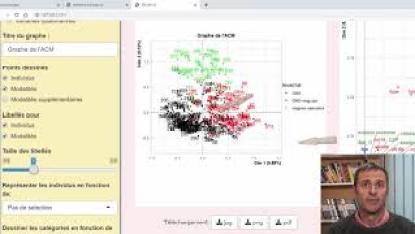Want to share your content on R-bloggers? click here if you have a blog, or here if you don't.
All you need to do with MCA to analyse a survey is in Factoshiny!
MCA – Multiple Correspondence Analysis – is a method for exploring and visualizing data obtained from a survey or a questionnaire, i.e. datasets with categorical variables.
The function Factoshiny of the package Factoshiny allows you to perform MCA in a really easy way. You can include extras information such as quantitative variables, manage missing data, draw and improve the graphs interactively, draw confidence ellipses, have several numeric indicators as outputs, perform clustering on the MCA results, and even have an automatic interpretation of the results. Finally, the function returns the lines of code to parameterize the analysis and redo the graphs, which makes the analysis reproducible.
Implementation with R software
See this video and the audio transcription of this video:

The lines of code to do a MCA:
install.packages(Factoshiny) library(Factoshiny) data(tea) result <- Factoshiny(tea)
Course videos
Theorectical and practical informations on Multiple Correspondence Analysis are available in these 4 course videos:
Here are the slides and the audio transcription of the course.
Materials
Here is the material used in the videos:
- Hobbies data: the data set– Rmarkdown – the script with the outputs
- Tea data: the data set – Rmarkdown– the script with the outputs
Management of missing data
This video gives more information on the management of missing data in MCA.
If you want to see more methods on Exploratory Data Analysis, follow this link.
R-bloggers.com offers daily e-mail updates about R news and tutorials about learning R and many other topics. Click here if you're looking to post or find an R/data-science job.
Want to share your content on R-bloggers? click here if you have a blog, or here if you don't.




